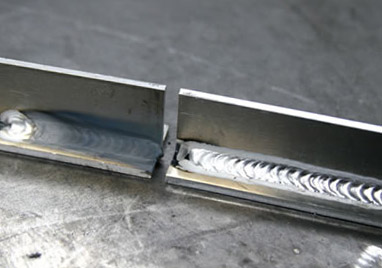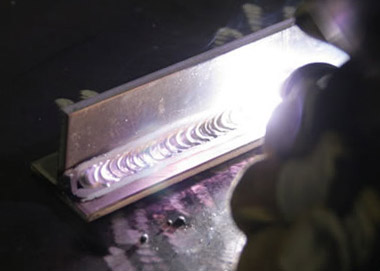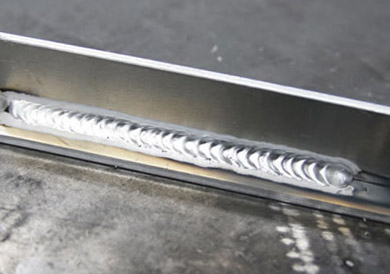Summary
The gas welding processes most commonly used on aluminum and aluminum alloys are oxyacetylene and oxyhydrogen.
Hydrogen may be burned with oxygen using the same tips as used with acetylene. However, the temperature is lower and larger tip sizes are necessary.
Oxyhydrogen welding permits a wider range of gas pressures than acetylene without losing the desired slightly reducing flame. Aluminum from 1/32 to 1 in. (0.8 to 25.4 mm) thick may be gas welded. Heavier material is seldom gas welded, as heat dissipation is so rapid that it is difficult to apply sufficient heat with a torch.
When compared with arc welding, the weld metal freezing rate of gas welding is very slow. The heat input in gas welding is not as concentrated as in other welding processes and unless precautions are taken greater distortion may result. Minimum distortion is obtained with edge or corner welds.
Comparison of Push and Drag Aluminum Gas Welding Techniques
The weld on the left was created using a “drag technique” where there was not enough coverage to clean the aluminum. The weld on the right is the result of the push technique, where there was the correct level of gas coverage.
Edge Preparation
Sheet or plate edges must be properly prepared to obtain gas welds of maximum strength. They are usually prepared the same as similar thicknesses of steel. However, on material up to 1/16 in. (1.6 mm) thick, the edges can be formed to a 90 degree flange. The flanges prevent excessive warping and buckling. They serve as filler metal during welding.
Welding without filler rod is normally limited to the pure aluminum alloys since weld cracking can occur in the higher strength alloys.
In gas welding, thickness over 3/16 in. (4.8 mm), the edges should be beveled to secure complete penetration. The included angle of bevel may be 60 to 120 degrees.
Preheating of the parts is recommended for all castings and plate 1/4 in. (6.4 mm) thick or over. This will avoid severe thermal stresses and ensure good penetration and satisfactory welding speeds. The common practice is to preheat to a temperature of 700ºF (371ºC). Thin material should be warmed with the welding torch prior to welding. Even this slight preheat helps to prevent cracks.
Heat-treated alloys should not be preheated above 800ºF (427ºC), unless they are to be post-weld heat treated. Preheating above 800ºF (427ºC) will cause a “hot-short” and the metal strength will deteriorate rapidly.
Aluminum Weld Travel Speed
Weld travel speed needs to increase as you weld to avoid too much melt-through on thin aluminum.
Preheat Temperature Checking Technique
When pyrolytic equipment (temperature gauges) is not available, the following tests can be made to determine the proper preheat temperatures.
- Char test: Using a pine stick, rub the end of the stick on the metal being preheated. At the proper temperatures, the stick will char. The darker the char, the higher the temperature.
- Carpenter’s chalk: Mark the metal with ordinary blue carpenter’s chalk. The blue line will turn white at the proper preheat temperature.
- Hammer test: Tap the metal lightly with a hand hammer. The metal loses its ring at the proper preheat temperature.
- Carburizing test: Carburize the surface of the metal, sooting the entire surface. As the heat from the torch is applied, the soot disappears. At the point of soot disappearance, the metal surface is slightly above 300ºF (149ºC). Care should be used not to coat the fluxed area with soot. Soot can be absorbed into the weld, causing porosity.
Welding Flame
A neutral or slightly reducing flame is recommended for welding aluminum. Oxidizing flames will cause the formation of aluminum oxide, resulting in poor fusion and a defective weld.
Welding Fluxes
Aluminum welding flux is designed to remove the aluminum oxide film and exclude oxygen from the vicinity of the puddle.
The fluxes used in gas welding are usually in powder form and are mixed with water to form a thin paste.
The flux should be applied to the seam by brushing, sprinkling, spraying, or other suitable methods. The welding rod should also be coated. The flux wil1 melt below the welding temperature of the metal and form a protective coating on the surface of the puddle. This coating breaks up the oxides, prevents oxidation, and permits slow cooling of the weld.
WARNING:
The acid solutions used to remove aluminum welding and brazing fluxes after welding or brazing are toxic and highly corrosive. Goggles, rubber gloves, and rubber aprons must be worn when handling the acids and solutions. Do not inhale fumes. When spilled on the body or clothing, wash immediately with large quantities of cold water. Seek medical attention. Never pour water into acid when preparing solutions; instead, pour acid into water. Always mix acid and water slowly. These operations should only be performed in well-ventilated areas.
(d) The aluminum welding fluxes contain chlorides and fluorides. In the presence of moisture, these will attack the base metal. Therefore, all flux remaining on the joints after welding must be completely removed.
If the weld is readily accessible, it can be cleaned with boiling water and a fine brush.
Parts having joints located so that cleaning with a brush and hot water is not practical may be cleansed by an acid dip and a cold or hot water rinse. Use 10 percent sulfuric acid cold water solution for 30 minutes or a 5 percent sulfuric acid hot water (150ºF (66ºC)) solution for 5 to 10 minutes for this purpose.
Aluminum Weld Oxidation
When Aluminum Comes in Contact with Oxygen in the air it oxidizes.
The light strips at the top and bottom of the weld are the removal of oxide by the use of the torch arc and argon gas during the welding process.
Welding Technique
After the material to be welded has been properly prepared, fluxed, and preheated, the flame is passed in small circles over the starting point until the flux melts.
The filler rod should be scraped over toe surface at three or four-second intervals, permitting the filler rod to come clear of the flame each time.
The scraping action will reveal when welding can be started without overheating the aluminum. The base metal must be melted before the filler rod is applied.
Forehand welding is generally considered best for welding on aluminum, since the flame will preheat the area to be welded. In welding thin aluminum, there is little need for torch movement other than progressing forward.
On material 3/16 in. (4.8 mm) thick and over, the torch should be given a uniform lateral motion. This will distribute the weld metal over the entire width of the weld. A slight back-and-forth motion will assist the flux in the removal of oxide.
The filler rod should be dipped into the weld puddle periodically, and withdrawn from the puddle with a forward motion. This method of withdrawal closes the puddle, prevents porosity, and assists the flux in removing the oxide film.



Hey Jeff,
Can . 1/8 piece of Aluminium be gas welded to a thicker piece say 1/4 -3/8ths
Hi, Thanks for info above, really useful. Just wondering if you can weld aluminium with mapp gas and oxy. I have a large oxy bottle but only use mapp gas as welding at home. I am restoring an old lea-francis and have made most of the panels myself and am reaching the stage where i need to weld up the rear boot area which is all in aluminium. I have brought some alu flux and standard rods (non fluxed) and am just buying a mapp gas regulator to lower the pressure. Will mapp gas give ok results as I’ve heard it burns with a different type of flame so not sure on settings and how to go about it. I had a go on a bit of scrap as was dying to try it and got great penetration but it did distort the metal somewhat and not sure how to get the correct flame. Cheers, Jeff
What do you mean by standard rods?….there are various low melting point Alumininium soldering/ brazing rods available. Durafix, HTS 2000 and Lumiweld to name a few…They all come with instructions and are all shown on YouTube..You need to practice on similar scrap pieces before to attempt to join the actual parts…it’s fairly easy to melt the parts if your not careful. They are fairly expensive and cheaper the more you buy…
Good luck..👍